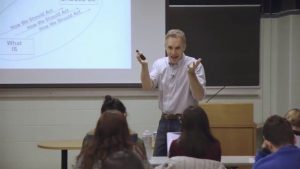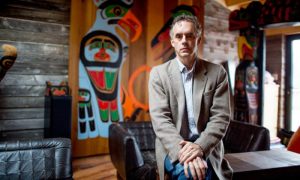
The following three-part series provides a first-hand account of one stop on Jordan Peterson’s recent 45-city tour promoting his bestselling book 12 Rules for Life: An Antidote to Chaos, with popular political commentator Dave Rubin. In part one I provide some background on the Peterson phenomenon, followed by a detailed account of one of his rallies in part two. Here in part three I offer some thoughts on how we might situate this phenomenon within broader cultural trends, with a tidbit on my own experience sitting in on a few of Peterson’s classes during my undergraduate years at the University of Toronto.
Are there 3 things that I leaned from attending a Jordan Peterson rally, as my title suggests? Perhaps, but in the world of YouTube algorithms it’s all about what gets clipped and what gets clicked. [1] I’ll leave it up to others to determine who “changed” whose life, who got “destroyed,” or whether anything was “calmly dismantled” here–be it feminism, the “radical left,” or Peterson himself.
I sat-in on a number of Peterson’s psychology classes when I was an undergraduate at the University of Toronto, now many moons ago. A friend had insisted that I come and see this eccentric professor in action, whose then-recent book, Maps of Meaning: The Architecture of Belief (1999), had so fascinated her. While Peterson was not well known at the time, the classes I attended were being filmed as part of a series on his book with TV Ontario (TVO), which is a useful resource for anyone interested in tracing the evolution of his ideas and presentation style (fedora-clad Peterson in the image above is from an appearance on TVO). When considering his current role as a charismatic (father) figure it is also significant to note these earlier efforts as evidence of a personality that has long sought-after a wider audience for his ideas, including, as noted in my previous post, expressing a desire to start his own church, along with his current project to launch an on-line university. Ultimately, it was social media (esp. YouTube) that enabled Peterson’s rise, while championing free speech and critiquing identity politics on the left was the million-dollar recipe that catapulted him to international fame.

Recollection is a tricky thing, especially when it’s nearly 15 years removed. I do recall how Peterson would walk back and forth at the front of the classroom with calm, deliberate steps, occasionally pausing for effect, while baring that same serious scowl and provocative tone that many are familiar with today. [2] I remember him talking about Nietzsche and Dostoyevsky, and warning the room full of undergrads in attendance (who were hanging on his every word) that drinking coffee while smoking was a terrible idea for one’s health. I can’t recall much else, to be honest, save for the feeling that he had a lot of knowledge that I lacked at the time, and that his attempts to weave together his expertise as a clinical psychologist with perennial myths of the Western canon (and with a healthy dollop of dark-night-of-the-soul existential philosophy) had a certain appeal to my early 20-something self.
There is an interesting thread running between Peterson’s “self-help” persona that aims to empower individuals toward self-actualization through a series of rules that hold the promise of social advancement (e.g., through cultivating personal responsibility, moving on up from beta-to-alpha, gaining romantic and material success, etc.), and his professorial-cum-charismatic cult of personality that he draws upon, and, crucially, is drawn upon by others to legitimize the ideologies of individualism, free markets, traditional gender roles, and ‘Western’ values, all of which function as a foil to the perceived chaos of social change that challenges the status quo.

What is perhaps most interesting about the Peterson phenomenon is what he appeals to in his (mostly young and male) audience, and how this contributes to a series of realignments of certain social identities. For example, while Peterson’s rationalism, quasi-scientism, and critique of/disdain for post-modernism, “Neo-Marxism” and “political correctness” aligns with popular atheist sensibilities cultivated by the likes of Richard Dawkins, Sam Harris, and the late Christopher Hitchens,* he also identifies as a Christian, has attacked atheism publicly, and adheres to a Jungian theory of archetypes popularized by Joseph Campbell. Indeed, the image pictured above from Peterson’s home in Toronto parallels photographs of Carl Jung’s estate in Switzerland, where symbols, deities, and images from a wide variety of cultures were collected and mounted like trophy bucks. [3] Although Peterson’s promotion of the (Christian) Bible as the foundational narrative for Western civilization is nothing new, his unique popularity is worth paying attention to as a cipher for (among many other things) a possible re-mapping of Christian narratives (e.g., as allegories for individualism and for taking personal responsibility), and as a touchstone for debates over (Western) cultural identity, especially for libertarian, “classical liberal,” and conservative-leaning political formations that are in search of a more stable identity.
*For an excellent analysis of the politics of the ‘new atheism’ see Stephen LeDrew’s The Evolution of Atheism: The Politics of a Modern Movement.
[1] Photo credit: https://boingboing.net/2018/09/21/jordan-peterson-threatened-to.html
[2] Photo credit: https://www.pinterest.com/pin/563301865881904292/
[3] Photo credit: https://www.theguardian.com/global/2018/jan/21/jordan-peterson-self-help-author-12-steps-interview
